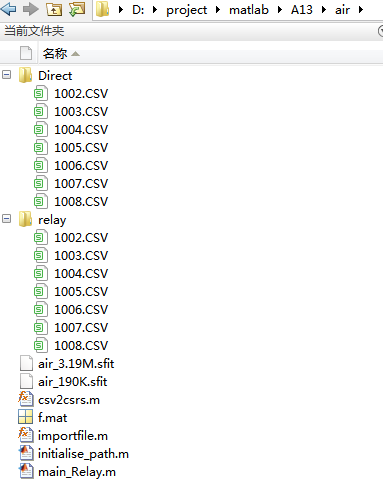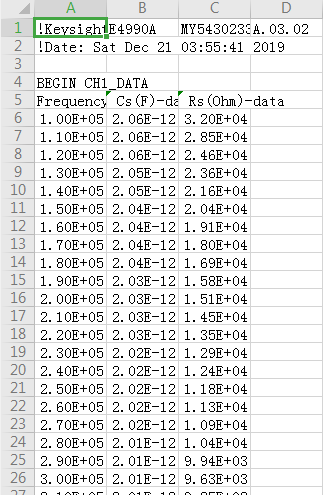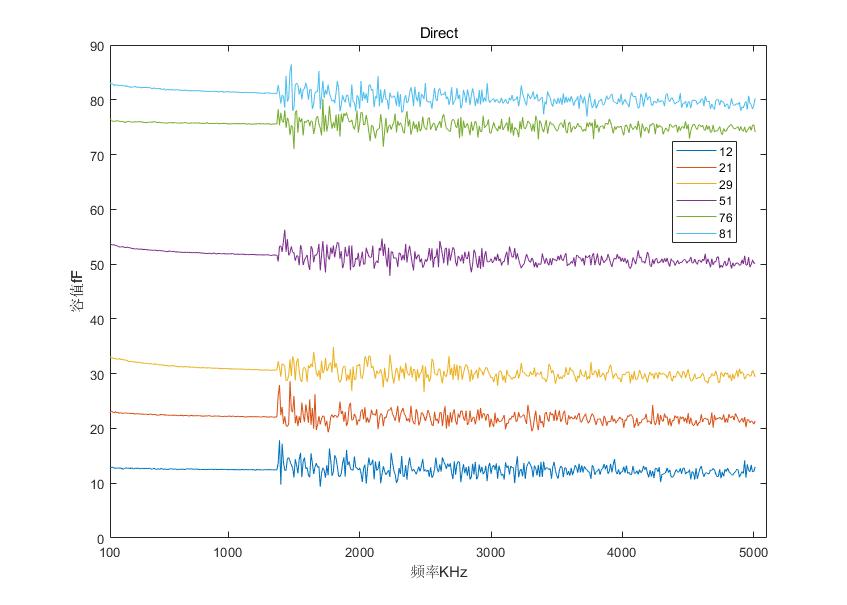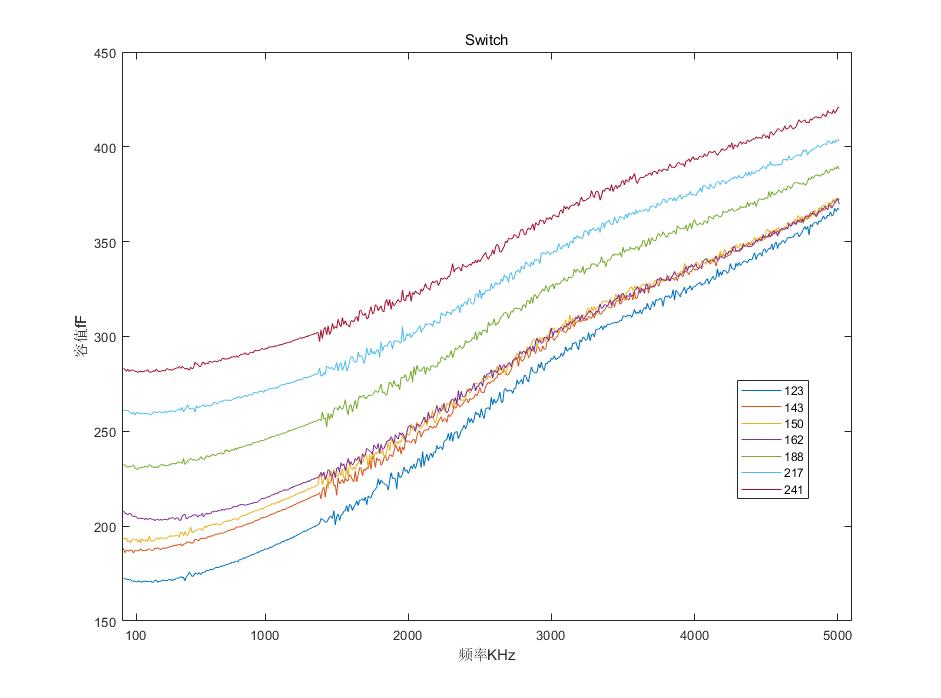下面代码是批量处理csv文件,读取里面的数据并做相关成图
- 获取文件路径
- 匹配文件名
- 读取文件中的某列数据中的某行到某行
- 多个数据成图在一起
- 生成变量,便于使用Curve Fitting工具,观察其线性相关程度
数据说明
首先是一系列CSV文件,是阻抗分析仪测量传感器Cs-Rs模型的数据,当然可以通过公式转换成相位幅值,如下图所示
然后是csv文件


下面代码分别是main_Relay.m,initialise_path.m,csv2csrs.m文件
clear
load('f.mat')
f=f(1:501);
list=dir('D:projectmatlabA13airrelay*.CSV');
for i=1:length(list)
B = regexp(list(i).name,'w*d','Match');
C(i)=str2double(B);
end
C = sort(C);
C_relay=zeros(501,length(C));
R_relay=zeros(501,length(C));
for i=1:length(C)
filename=strcat('D:projectmatlabA13airrelay',num2str(C(i)),'.csv');
[Cs,Rs] = csv2csrs(filename);
C_relay(:,i)=Cs;
R_relay(:,i)=Rs;
end
C_direct=zeros(501,length(C));
R_direct=zeros(501,length(C));
for i=1:length(C)
filename=strcat('D:projectmatlabA13airDirect',num2str(C(i)),'.csv');
[Cs,Rs] = csv2csrs(filename);
C_direct(:,i)=Cs;
R_direct(:,i)=Rs;
end
figure
for i = 10:25:501
plot(C_direct(i,:),C_relay(i,:));
hold all
end
x=C_relay(310,:);
y=C_direct(310,:);
delta_C=C_relay-C_direct;
delta_R=R_relay-R_direct;
function Untitled = importfile(filename, startRow, endRow)
%IMPORTFILE Import numeric data from a text file as a matrix.
% UNTITLED = IMPORTFILE(FILENAME) Reads data from text file FILENAME for
% the default selection.
%
% UNTITLED = IMPORTFILE(FILENAME, STARTROW, ENDROW) Reads data from rows
% STARTROW through ENDROW of text file FILENAME.
%
% Example:
% Untitled = importfile('150.CSV', 5, 505);
%
% See also TEXTSCAN.
% Auto-generated by MATLAB on 2019/12/14 17:51:15
%% Initialize variables.
if nargin<=2
startRow = 5;
endRow = 505;
end
%% Read columns of data as text:
% For more information, see the TEXTSCAN documentation.
formatSpec = '%20s%21s%s%[^nr]';
%% Open the text file.
fileID = fopen(filename,'r');
%% Read columns of data according to the format.
% This call is based on the structure of the file used to generate this
% code. If an error occurs for a different file, try regenerating the code
% from the Import Tool.
textscan(fileID, '%[^nr]', startRow(1)-1, 'WhiteSpace', '', 'ReturnOnError', false);
dataArray = textscan(fileID, formatSpec, endRow(1)-startRow(1)+1, 'Delimiter', '', 'WhiteSpace', '', 'TextType', 'string', 'ReturnOnError', false, 'EndOfLine', 'rn');
for block=2:length(startRow)
frewind(fileID);
textscan(fileID, '%[^nr]', startRow(block)-1, 'WhiteSpace', '', 'ReturnOnError', false);
dataArrayBlock = textscan(fileID, formatSpec, endRow(block)-startRow(block)+1, 'Delimiter', '', 'WhiteSpace', '', 'TextType', 'string', 'ReturnOnError', false, 'EndOfLine', 'rn');
for col=1:length(dataArray)
dataArray{col} = [dataArray{col};dataArrayBlock{col}];
end
end
%% Close the text file.
fclose(fileID);
%% Convert the contents of columns containing numeric text to numbers.
% Replace non-numeric text with NaN.
raw = repmat({''},length(dataArray{1}),length(dataArray)-1);
for col=1:length(dataArray)-1
raw(1:length(dataArray{col}),col) = mat2cell(dataArray{col}, ones(length(dataArray{col}), 1));
end
numericData = NaN(size(dataArray{1},1),size(dataArray,2));
for col=[1,2,3]
% Converts text in the input cell array to numbers. Replaced non-numeric
% text with NaN.
rawData = dataArray{col};
for row=1:size(rawData, 1)
% Create a regular expression to detect and remove non-numeric prefixes and
% suffixes.
regexstr = '(?<prefix>.*?)(?<numbers>([-]*(d+[,]*)+[.]{0,1}d*[eEdD]{0,1}[-+]*d*[i]{0,1})|([-]*(d+[,]*)*[.]{1,1}d+[eEdD]{0,1}[-+]*d*[i]{0,1}))(?<suffix>.*)';
try
result = regexp(rawData(row), regexstr, 'names');
numbers = result.numbers;
% Detected commas in non-thousand locations.
invalidThousandsSeparator = false;
if numbers.contains(',')
thousandsRegExp = '^d+?(,d{3})*.{0,1}d*$';
if isempty(regexp(numbers, thousandsRegExp, 'once'))
numbers = NaN;
invalidThousandsSeparator = true;
end
end
% Convert numeric text to numbers.
if ~invalidThousandsSeparator
numbers = textscan(char(strrep(numbers, ',', '')), '%f');
numericData(row, col) = numbers{1};
raw{row, col} = numbers{1};
end
catch
raw{row, col} = rawData{row};
end
end
end
%% Create output variable
Untitled = table;
Untitled.KeysightTechnologi = cell2mat(raw(:, 1));
Untitled.esE4990AMY54302337 = cell2mat(raw(:, 2));
Untitled.A0302 = cell2mat(raw(:, 3));
function [Cs,Rs] = csv2csrs(filename)
Z_table=importfile(filename);
Cs=table2array(Z_table(:,2));
Rs=table2array(Z_table(:,3));
end下面是通过matlab的绘图工具直接对工作区的变量成图。




最后
以上就是超级魔镜最近收集整理的关于matlab的一些记录1的全部内容,更多相关matlab内容请搜索靠谱客的其他文章。
本图文内容来源于网友提供,作为学习参考使用,或来自网络收集整理,版权属于原作者所有。








发表评论 取消回复